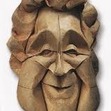Nick Robinson's Blog, page 45
March 14, 2011
Back when paper was for writing on as well as folding…
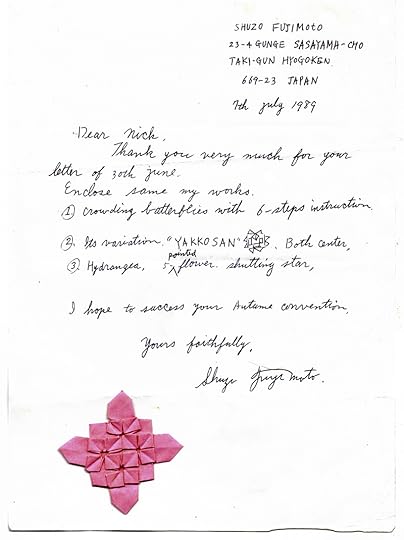 Being a collecting kinda guy, I've got several lever arch files of correspondence from my early origami days (84 onwards) and every few years, I have a read through some. Email may be quicker and easier, but there's no memory like a hand-written letter from an old friend.
Being a collecting kinda guy, I've got several lever arch files of correspondence from my early origami days (84 onwards) and every few years, I have a read through some. Email may be quicker and easier, but there's no memory like a hand-written letter from an old friend.
A response from Paul Jackson, then mag editor, to the blue foil slug I sent him – he said "shame about the foil – YUK"!. Brilly, inviting me to my first ever mini-meeting, Yoshizawa, thanking me for some models, regular 8 page hand-written epics from Robert Lang, usually with diagrams on the back, Thoki Yenn's amazing letters, Vicente Palacios, Momotani, I wrote to 'em all and always had a reply, frequently with folded models.
Here's a nice little message from Shuzo Fujimoto, replying to a request for models for a convention I organised in '89. I think it was the first time his "crowded butterflies" had been seen. Click it to see a larger version. You younger folders, it's still not too late to change your ways; if someone writes to me via snail (such a derogatory word!) I always reply in kind. OK, they will be typed & printed, but that's because my hand-writing is all but illegible. Instead of firing off emails, why not send a real letter to your heroes and see what happens?
March 12, 2011
Origami Alfresco (Part the 2nd) : David Mitchell
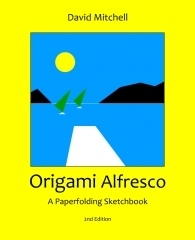 David's first edition of this book dates back to 2000 and ten years is a long time in origami, so a reprint is long overdue. The 2nd edition has slightly smaller dimensions than the first, yet more pages, so perhaps it could be described as "revised, expanded and contracted".
David's first edition of this book dates back to 2000 and ten years is a long time in origami, so a reprint is long overdue. The 2nd edition has slightly smaller dimensions than the first, yet more pages, so perhaps it could be described as "revised, expanded and contracted".
Few authors get the opportunity to revisit earlier books (if only!) so whilst the medium of self-publishing has its pitfalls, this at least is one huge benefit, providing you know when to stop revising! The 29 original models are expanded to 50 and page count from 44 to 136. The designs are divided into discrete sections; Animals/Paper, Inanimate Objects, Double Images, The Sea and Landscapes. These are briefly explained in the "about the designs" section, where we are allowed to see a little of the way into Mitchell's fascinating mind. Personally, I would have enjoyed reading more in this section, but it's never easy putting ideas into words!
Never a conventional creator, David (I conjecture) cares little about technique for its own sake, but seeks origami that challenges, warps, intrigues and possibly even confuses. It's as much about the way the mind works as about how paper can be folded. As in my review of the first edition, I'd make a comparison with the work of Kenneway. It's fair to say that I also produce work of this nature from time to time – the author and we used to bat many folding ideas back and forth when we were younger men ;)
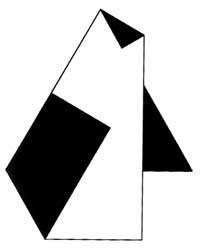 The diagrams are excellent, as is to be expected. I miss the little black/white "finished model" images used on the first page of each model in the earlier edition. An index would have been simple to add, as would a link/reference to the BOS. No folder of any modest ability will struggle to reproduce the models, although perfecting some of the "by eye" proportions may take some time.
The diagrams are excellent, as is to be expected. I miss the little black/white "finished model" images used on the first page of each model in the earlier edition. An index would have been simple to add, as would a link/reference to the BOS. No folder of any modest ability will struggle to reproduce the models, although perfecting some of the "by eye" proportions may take some time.
No Mitchell book would be complete without at least one small conceit, this time it's coining a new word for what is commonly known as kami paper, calling it "irogami". According to google, this is an Ipad app to make simple coloured drawings. Still, it may catch on! It also takes a brave man to describe himself on the homepage of his website as a "unique creative talent", but there's no arguing that he is a hugely talented creator!
You can buy the book for a cent under $20 from this site and I'd say most people will find something to enjoy and (unusually) to think about within. What more can you ask of a book? I look forward to revisions of his other excellent volumes in the future. Every copy sold of this book will encourage David to do just that.
I'd like to thank the author sincerely for sending me a review copy.
Oirgami Alfresco (Part the 2nd) : David Mitchell
 David's first edition of this book dates back to 2000 and ten years is a long time in origami, so a reprint is long overdue. The 2nd edition has slightly smaller dimensions than the first, yet more pages, so perhaps it could be described as "revised, expanded and contracted".
David's first edition of this book dates back to 2000 and ten years is a long time in origami, so a reprint is long overdue. The 2nd edition has slightly smaller dimensions than the first, yet more pages, so perhaps it could be described as "revised, expanded and contracted".
Few authors get the opportunity to revisit earlier books (if only!) so whilst the medium of self-publishing has its pitfalls, this at least is one huge benefit, providing you know when to stop revising! The 29 original models are expanded to 50 and page count from 44 to 136. The designs are divided into discrete sections; Animals/Paper, Inanimate Objects, Double Images, The Sea and Landscapes. These are briefly explained in the "about the designs" section, where we are allowed to see a little of the way into Mitchell's fascinating mind. Personally, I would have enjoyed reading more in this section, but it's never easy putting ideas into words!
Never a conventional creator, David (I conjecture) cares little about technique for its own sake, but seeks origami that challenges, warps, intrigues and possibly even confuses. It's as much about the way the mind works as about how paper can be folded. As in my review of the first edition, I'd make a comparison with the work of Kenneway. It's fair to say that I also produce work of this nature from time to time – the author and we used to bat many folding ideas back and forth when we were younger men ;)
 The diagrams are excellent, as is to be expected. I miss the little black/white "finished model" images used on the first page of each model in the earlier edition. An index would have been simple to add, as would a link/reference to the BOS. No folder of any modest ability will struggle to reproduce the models, although perfecting some of the "by eye" proportions may take some time.
The diagrams are excellent, as is to be expected. I miss the little black/white "finished model" images used on the first page of each model in the earlier edition. An index would have been simple to add, as would a link/reference to the BOS. No folder of any modest ability will struggle to reproduce the models, although perfecting some of the "by eye" proportions may take some time.
No Mitchell book would be complete without at least one small conceit, this time it's coining a new word for what is commonly known as kami paper, calling it "irogami". According to google, this is an Ipad app to make simple coloured drawings. Still, it may catch on! It also takes a brave man to describe himself on the homepage of his website as a "unique creative talent", but there's no arguing that he is a hugely talented creator!
You can buy the book for a cent under $20 from this site and I'd say most people will find something to enjoy and (unusually) to think about within. What more can you ask of a book? I look forward to revisions of his other excellent volumes in the future. Every copy sold of this book will encourage David to do just that.
I'd like to thank the author sincerely for sending me a review copy.
March 10, 2011
You'll have someone's eye out with that….
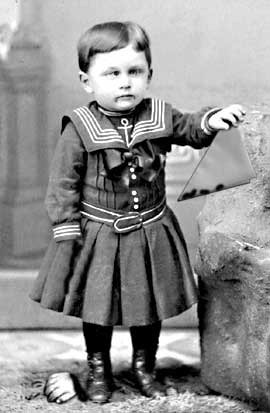 When I'm submitting proposals for working with the public, health and safety assessments are a typical element. I have a "set text" covering paper-cuts and making sure the nose of any paper planes are suitably blunted, which usually suffices.
When I'm submitting proposals for working with the public, health and safety assessments are a typical element. I have a "set text" covering paper-cuts and making sure the nose of any paper planes are suitably blunted, which usually suffices.
However, a recent job highlighted a danger for which I had been blissfully unaware, that of paper bangers. Not the noise, you understand, but the fact that the action of "firing" them requires a violent movement of the arm. Clearly, if some unfortunate child were to walk underneath the arm, it could lead to headaches, concussion, broken (or severed, see right) limbs or even a slow and lingering death. "Who had approved the use of this dangerous form of origami?" I was asked.
Clearly, I need to take my work more seriously and re-evaluate models I had assumed were non-lethal. Please feel free to use the following list of dangers when you work with the public;
strained wrist due to excessive flapping
ligament damage through repeated jumping of frogs
burned fingers caused by over-enthusiastic creasing
lung damage when blowing up frog's rear end
hair loss due to frustration when folding cuckoo clocks
What other dangers can you think of?
March 5, 2011
I shared it on the grapevine
 When questioned about the morality of producing and exchanging illegal ori-e-books, a standard answer is, well, many classic books are long out of print and so hard to find. It's easy to see this as a justification, except that the whole perspective is skewed by the prevalence of file-sharing and the common belief that "if it's out there for free, why shouldn't I have it?"
When questioned about the morality of producing and exchanging illegal ori-e-books, a standard answer is, well, many classic books are long out of print and so hard to find. It's easy to see this as a justification, except that the whole perspective is skewed by the prevalence of file-sharing and the common belief that "if it's out there for free, why shouldn't I have it?"
I watched a documentary last night on the singer/songwriter Ron Sexsmith and was struck by several tracks from his new CD. I'm certain I could have found a torrent and be listening to it within half an hour, but how are musicians (and origami authors) to survive if their readers / fans adopt this attitude wholesale? I admire this mans work immensely, so adding an extra sale is the least I can do.
We should also cast our minds back to the 70s, when it was still just about possible to own every origami book in the world, with some effort. Folders then had no internet, no CDs, no computers! Yet they managed to sustain themselves from the available resources they had and if they wanted a specific book, they had to contact 2nd hand book shops and spread the word.
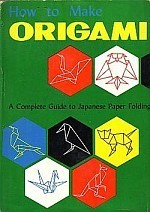 I'm not suggesting we set the clocks back, it's out there and I don't see how it can be stopped. However, today's web-savvy folders take many things for granted and have scant defense when you question file-sharing ("I'd never download one of your books Nick!")
I'm not suggesting we set the clocks back, it's out there and I don't see how it can be stopped. However, today's web-savvy folders take many things for granted and have scant defense when you question file-sharing ("I'd never download one of your books Nick!")
I should say, I have a chequered history of music torrenting myself, but I am trying to improve! The fact that you can get away with dubious/illegal activities doesn't mean, as moral beings, that we should. At every turn in our life we make decisions. I'd also argue that the joy of having an obscure book found on ebay (such as the Honda book shown here) come through the letter-box is hard to beat. The day I have my library on a hard drive is the day I shall turn my toes up & sleep the eternal sleep.
March 3, 2011
Ain't That Loving Your Baby
 In the modern era of the Tantedian, it's perhaps understandable if new folders are less familiar with older Japanese designers than they might to be. Fujimoto has been rediscovered by the tesselators, but names like Nakano, Takekawa and even Momotani sometimes fail to get the respect the deserve.
In the modern era of the Tantedian, it's perhaps understandable if new folders are less familiar with older Japanese designers than they might to be. Fujimoto has been rediscovered by the tesselators, but names like Nakano, Takekawa and even Momotani sometimes fail to get the respect the deserve.
One such is Toyoaki Kawai. In the 1960s he was a leading figure in promoting origami – please read David Lister's short but interesting article on his work. Tomoko Fuse herself studied for 2 1/2 years with Kawai, you can see his influence in her early book of masks.
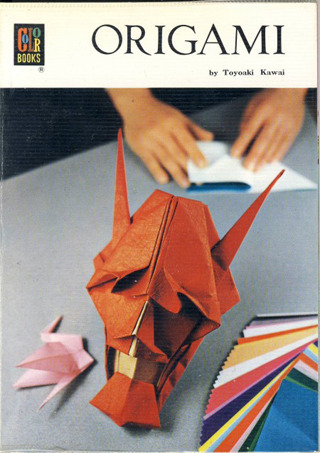 I came across his work with one of the first books in my collection, a small but intriguing book called "Colorful Origami" (1970). This, along with the follow-up "Japan's Creative Origami" can be picked up fairly cheaply on the net.
I came across his work with one of the first books in my collection, a small but intriguing book called "Colorful Origami" (1970). This, along with the follow-up "Japan's Creative Origami" can be picked up fairly cheaply on the net.
The inspiration for this entry is that I recently worked with a woman who was due to give birth in a few weeks, so I folded Kawai's "Crawling baby" and as I am wont to do, glued it's little feet into a card to make a pop-up. I think it's a classic.
Early in the sequence, a flap is squashed, but it leaves a small asymmetric edge at the end. Instead of adjusting the fold to remove it, Kawai turned it to his advantage, forming the hands of the baby. It's full of life and makes people smile – what more can you ask?
March 1, 2011
National Maritime Museum
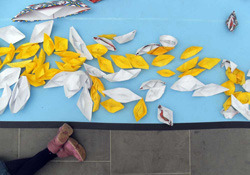 Just back from two highly eventful days in Greenwich, London, working for the National Maritime Museum. The Museum itself is a highly impressive building built in 1807 and surrounded by naval buildings of all kind, including one housing the Cutty Sark, unfortunately still being restored and under wraps.
Just back from two highly eventful days in Greenwich, London, working for the National Maritime Museum. The Museum itself is a highly impressive building built in 1807 and surrounded by naval buildings of all kind, including one housing the Cutty Sark, unfortunately still being restored and under wraps.
An artist called Yinka Shonibare had created a giant model of Nelson's boat "Victory" inside a bottle, which seemed a good enough reason for the museum to recreate the Battle of Trafalgar using origami boats!
The upstairs gallery was a large tiled area, where we taped down large strips of blue paper to form the sea. A quickly drawn compass to indicate which way the wind was blowing and we were set for action.
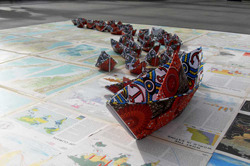 Two tables were set up, where visitors had the choice of folding themselves using some printed instructions, folding with myself or helpers Sarah and Sonia, or having us fold it for them (if they were just too young). It didn't take long for hundreds of boats to take shape; patterned for the English fleet and white or yellow ones for the French & Spanish.
Two tables were set up, where visitors had the choice of folding themselves using some printed instructions, folding with myself or helpers Sarah and Sonia, or having us fold it for them (if they were just too young). It didn't take long for hundreds of boats to take shape; patterned for the English fleet and white or yellow ones for the French & Spanish.
One visitor was having a good "pop" at the Spanish, not realising they were stood next to some visitors from Spain. I managed to calm things down by saying hello in my best fluent (6 classes so far) Spanish and then asking for a second class return ticket to Bercelona.
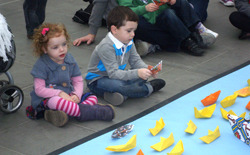 The double-sided pattern for the ship was prepared by Shonibare but unfortunately, only worked one way – folding with the wrong side upwards produced an all white boat! We also had some single-side A2 sheets, which I laminated together for some larger ships.
The double-sided pattern for the ship was prepared by Shonibare but unfortunately, only worked one way – folding with the wrong side upwards produced an all white boat! We also had some single-side A2 sheets, which I laminated together for some larger ships.
Twice during each day, a recreation of the battle was led by expert David, who enthusiastically led use through the fascinating story of the battle, which led to Nelson's death, shot by a sniper.
What was extraordinary was the way in which visitors were delighted to sit on the stone floor and fold, both young and old, forming something akin to Greenham Common. They really "got it" and for hours, the floor was awash with folding.
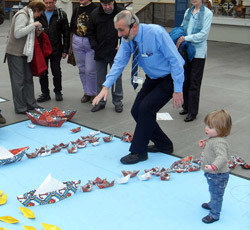 As is always the case, I had numerous requests for subjects other than a simple boat; a whale, box, snake, crane, penguin, oil tanker(!) and a dragon. The latter was Robert Neal's classic dragon, which takes five minutes or so. I handed it over and he stood there impassively. I asked what else he wanted "I need another dragon for my brother"….
As is always the case, I had numerous requests for subjects other than a simple boat; a whale, box, snake, crane, penguin, oil tanker(!) and a dragon. The latter was Robert Neal's classic dragon, which takes five minutes or so. I handed it over and he stood there impassively. I asked what else he wanted "I need another dragon for my brother"….
All in all, a highly successful weekend, where origami was used to enhance an educational talk and provided entertainment and stimulation for many people. My thanks to Louisa and all at the National Maritime Museum – I hope we can work together again in the future.
February 24, 2011
Soon we'll be ship-building…
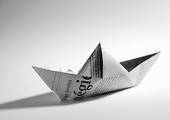 I have a fascinating weekends work lined up, down in London at the National Maritime Museum in Greenwich. My mission is to help members of the public build enough paper boats to do a re-enactment of the Battle of Trafalgar!
I have a fascinating weekends work lined up, down in London at the National Maritime Museum in Greenwich. My mission is to help members of the public build enough paper boats to do a re-enactment of the Battle of Trafalgar!
I'll be making the larger "flag ships" and teaching people to make smaller ones, using the trad "rectangular boat with sail". It will be happening both days, starting at 12 and again at 3pm. I hope to see some folders there!?
Tweety Pingu!
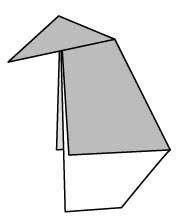 I've been asked to provide diagrams for a traditional penguin. The client intends to tweet text instructions, one line at a time, then release the diagram on the final tweet. I've not had much interaction with twitter – I signed up 18 months or so ago, found I had 4 followers on the first day and promptly cancelled my account, slightly freaked out!
I've been asked to provide diagrams for a traditional penguin. The client intends to tweet text instructions, one line at a time, then release the diagram on the final tweet. I've not had much interaction with twitter – I signed up 18 months or so ago, found I had 4 followers on the first day and promptly cancelled my account, slightly freaked out!
Anyway, trying to condense instructions to 40 characters has proved nearly impossible – could you manage from the following?
1 Crease a diagonal then unfold it
2 Fold two sides to the diagonal, forming a kite
3 Fold the sharp corner to the centre of the paper
4 Turn over and fold the lower corner upwards
5 Fold in half along the vertical centre crease.
6 Pull out and squash the beak into place
7 Complete
February 21, 2011
Puzzling design…
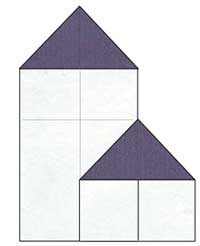 One the aspects of origami design I really enjoy is to be given a 2D target, then try to produce it from paper, neatly folded, edges locked away etc. It's a puzzle and generally one with many possible solutions.
One the aspects of origami design I really enjoy is to be given a 2D target, then try to produce it from paper, neatly folded, edges locked away etc. It's a puzzle and generally one with many possible solutions.
Whilst compiling the forthcoming BOS spring Model Collection, chairman Guy suggested we included the logo of the venue (the Campanile) and perhaps an origami version of it.
He showed me a picture of a Kenneway design which was never diagrammed due to an unsatisfactory folding method. Using it as inspiration, I produced something close (but not identical) to use on the cover. Of course, it had to have a decent sequence! Here's the result – why not see if you can produce it yourselves? The width of the tower is 1/4 of the square.

